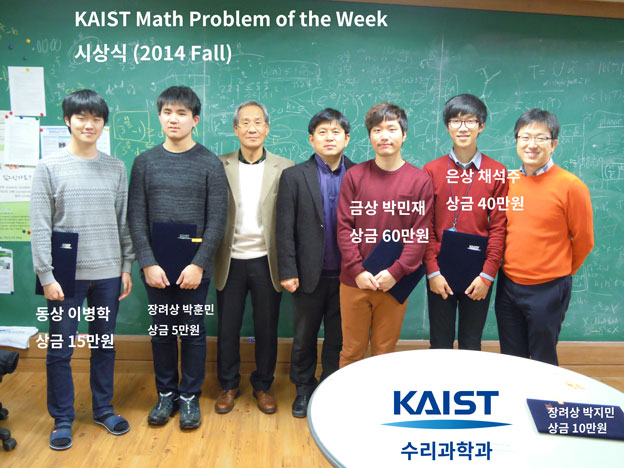Let \(\{a_n\}\) be a sequence of non-negative reals such that \( \lim_{n\to \infty} a_n \sum_{i=1}^n a_i^5=1\). Prove that \[ \lim_{n\to \infty} a_n (6n)^{1/6} = 1.\]
loading...

Let \(\{a_n\}\) be a sequence of non-negative reals such that \( \lim_{n\to \infty} a_n \sum_{i=1}^n a_i^5=1\). Prove that \[ \lim_{n\to \infty} a_n (6n)^{1/6} = 1.\]
Let \( A\) be a set of \(n\ge 2\) odd integers. Prove that there exist two distinct subsets \(X\), \(Y\) of \(A\) such that \[ \sum_{x\in X} x\equiv\sum_{y\in Y}y \pmod{2^n}.\]
The best solution was submitted by 이종원 (수리과학과 2014학번). Congratulations!
Here is his solution of problem 2015-1.
Alternative solutions were submitted by 고경훈 (2015학번, +3), 김경석 (2015학번, +3), 김기현 (2012학번, +3), 김동철 (2013학번, +3), 배형진 (마포고 1학년, +2), 어수강 (서울대 수리과학부 대학원생, +3), 엄태현 (2012학번, +3), 오동우 (2015학번, +3), 유찬진 (2015학번, +3), 윤성철 (홍익대 수학교육과, +3), 이명재 (수리과학과 2012학번, +3), 이병학 (2013학번, +3), 이상민 (수리과학과 2014학번, +3), 이수철 (2012학번, +3), 이시우 (POSTECH 수학과 2013학번, +3), 이영민 (2012학번, +3), 장기정 (수리과학과 2014학번, +3), 정성진 (2013학번, +3), 진우영 (수리과학과 2012학번, +3), 최두성 (수리과학과 2011학번, +3), 최인혁 (2015학번, +3), Muhammadfiruz Hassnov (2014학번, +3).
Let \(T\) be a triangle. Prove that if every point of a plane is colored by Red, Blue, or Green, then there is a triangle similar to \(T\) such that all vertices of this triangle have the same color.
Let \( A\) be a set of \(n\ge 2\) odd integers. Prove that there exist two distinct subsets \(X\), \(Y\) of \(A\) such that \[ \sum_{x\in X} x\equiv\sum_{y\in Y}y \pmod{2^n}.\]
Remark (added March 3): n is an integer greater than or equal to 2 and A is a set of n odd integers.
 Thanks all for participating POW actively. Here’s the list of winners:
Thanks all for participating POW actively. Here’s the list of winners:
박민재 (2011학번) 30
채석주 (2013학번) 22
이병학 (2013학번) 20
박지민 (2012학번) 19
박훈민 (2013학번) 15
장기정 (2014학번) 14
허원영 (2014학번) 4
정성진 (2013학번) 3
김태겸 (2013학번) 3
윤준기 (2014학번) 3
Suppose that \(n\) points are chosen randomly on a sphere. What is the probability that all points are on some hemisphere?
The best solution was submitted by 채석주 (수리과학과 2013학번). Congratulations!
Here is his solution of 2014-24.
An alternative solution was submitted by 이병학 (수리과학과 2013학번, +3).
Let \(f:[0,1]\to \mathbb R\) be a differentiable function with \(f(0)=0\), \(f(1)=1\). Prove that for every positive integer \(n\), there exist \(n\) distinct numbers \(x_1,x_2,\ldots,x_n\in(0,1)\) such that \[ \frac{1}{n}\sum_{i=1}^n \frac{1}{f'(x_i)}=1.\]
The best solution was submitted by Heo, Won Yeong (허원영), 2014학번. Congratulations!
Here is his solution of 2014-23.
Alternative solutions were submitted by 김태겸 (전기및전자공학과 2013학번, +3), 박민재 (수리과학과 2011학번, +3), 윤준기 (2014학번, +3), 장기정 (2014학번, +3), 박훈민 (수리과학과 2013학번, +3), 채석주 (수리과학과 2013학번, +3), 박지민 (전산학과 2012학번, +2), 이병학 (수리과학과 2013학번, +3), 어수강 (서울대학교 수리과학부, +3), 김동률 (강원과학고등학교 2학년, +3), 박지현 (경상고등학교 1학년, +3), 진형준 (인천대학교 수학과 2014학번, +3).
Suppose that \(n\) points are chosen randomly on a sphere. What is the probability that all points are on some hemisphere?
(This is the last problem of 2014. Thank you!)
For a nonnegative real number \(x\), let \[ f_n(x)=\frac{\prod_{k=1}^{n-1} ((x+k)(x+k+1))}{ (n!)^2}\] for a positive integer \(n\). Determine \(\lim_{n\to\infty}f_n(x)\).
The best solution was submitted by Hun-Min Park (박훈민), 수리과학과 2013학번. Congratulations!
Here is his solution of problem 2014-22.
Alternative solutions were submitted by 박민재 (수리과학과 2011학번, +3, his solution), 박지민 (전산학과 2012학번, +3), 이병학 (수리과학과 2013학번, +3), 채석주 (수리과학과 2013학번, +3).
Let \(f:[0,1]\to \mathbb R\) be a differentiable function with \(f(0)=0\), \(f(1)=1\). Prove that for every positive integer \(n\), there exist \(n\) distinct numbers \(x_1,x_2,\ldots,x_n\in(0,1)\) such that \[ \frac{1}{n}\sum_{i=1}^n \frac{1}{f'(x_i)}=1.\]